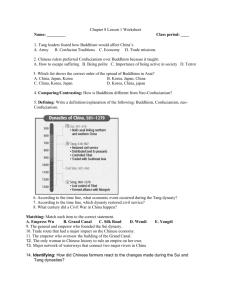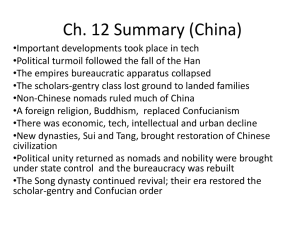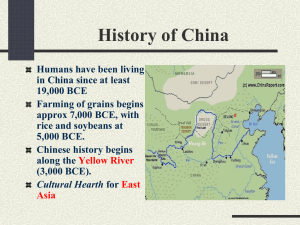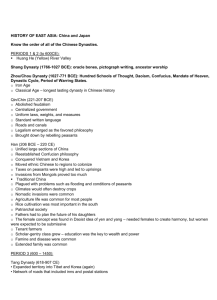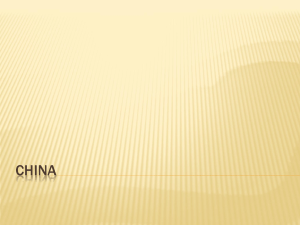The Chinese Way (Sao Chio)
advertisement
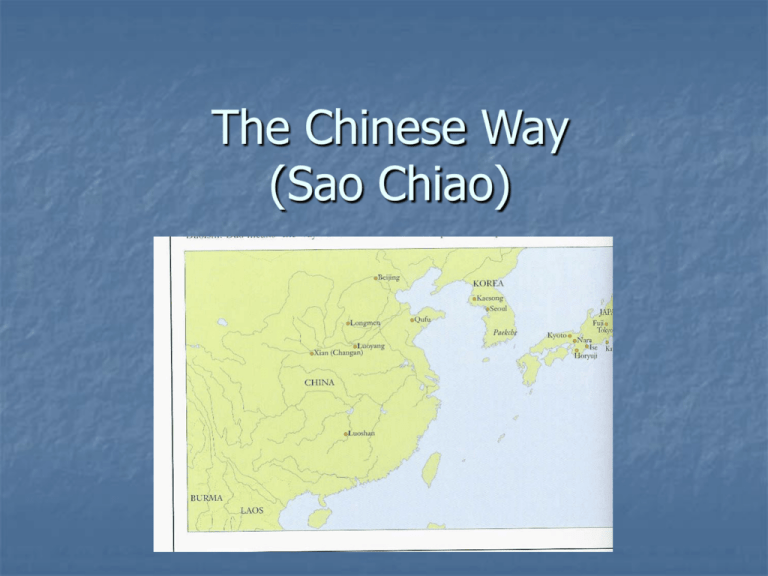
The Chinese Way (Sao Chiao) I. Introduction A. Religion in the Far East quite different than religion in India 1. Concern in India is “ultimate reality”—the Far East is not concerned with such issues 2. There is a radical humanism—a desire to live in this world 3. Humanity is the measure of all things 4. Humanity has no need for a savior, since humans are not sinful or evil 5. Humanity is basically good and only needs proper education of precepts or examples to live the virtuous life—no word for “sin” in Chinese 6. Thought could be seen as an ethical system, with stress on the state and peace 7. No concept of separating the sacred and secular 8. There are no dogmatic or categorical statements 9. The apprehension of truth is always partial B. Three faiths in China co-exist and a Chinese could belong to all three—they are complementary rather than rivals—thus the Sao Chio 1. Tao Chiao—Taoism 2. Ju Chiao—Confucianism a. Literally means the way of learning b. It is the most revered of the 3 traditions c. It stresses hope for humanity through education 3. Fo Chiao—Buddhism a. Fo is the word for Buddha b. It is a special appeal in face of death and afterlife Pre-History I. Three Cultural Heroes, 2800-2600 BCE A. Fu Hsi—inventor of writing, hunting, trapping, and fishing B. Shen Nung, inventor of agriculture and mercantilism C. Yellow Emperor (c2700 BCE), invented government and Taoist philosophy II. The Three Sage Kings A. Yao (2350 BCE) B. Shun (2250 BCE) C. Yu (2205 BCE) D. These kings ruled with perfect wisdom, clarity, and virtue E. In Chinese model of history, human events follow discernible cycles in which times of great virtue and wisdom are followed by times of decadence and decline First Emperor Background of Chinese Religion A. Confucius and Lao-Tse emphasized they were only transmitting the wisdom of the ancients B. Political history 1. Like most ancient cultures, Chinese culture centered around rivers a. Most important is the Yellow River b. Second most important is the Yangtse—it divided North and South China c. Third important river is the Si River 2. Government began with the Hsia Dynasty (c. 2005 BCE-1765 BCE) a. Last of sage kings, Yu, founded a dynasty of kings, Hsia b. Began with virtue and wisdom; ended with rule of Chieh who was decadent and cruel c. In 1766 BCE, Husia dynasty overthrown by T’ang, who founded the Shang dynasty 3. The Shang Dynasty was from 17651122 BCE a. Began worshipping Shang-ti—”Lord on High b. Ancestors dwelled in heaven after their death and continued to show interest in family c. Obligations to remember the ancestors 4. The Chou Dynasty was from 1122-721 BCE in the West and 276 BCE in the East a. Confucius and Lao-Tse lived in the East at this time b. Both went through experience of disillusionment with government c. Kingdom became divided d. Chou invented the t’ien ming (Mandate of Heaven) e. Chinese character for emperor (ti) consists of three horizontal lines joined by a vertical line—represents the connection between heaven (at top) and earth (at the bottom) f. Relationship is mediated by the emperor represented by the horizontal line g. Heaven “t’ien” desires that humans be provided for their needs; the emperor function to provide those needs h. If the emperor fails to see to the welfare of the people, heaven withdraws its mandate and invests it in another 5. From 722-221 BCE there was a gradual decay of the feudal system a. The Period of The One Hundred Schools (551-223 BCE) b. Most important figure is Kung Fu Tzu or Confucius c. Lao Tzu also wanted to reform government d. Mo Tzu was third major school e. Legalists emerged during latter years 6. In 221 BCE Shih-Huant-Ti united China again— considered to be one of the greatest of emperors C. Mythology of the first human 1. Pan-Kur was considered to be the first man a. He formed the earth and sky out of primeval chaos b. He lived for 1800 years c. His breath was the wind, voice the thunder, and the world grew as he grew d. His remains formed the sacred mountains of China e. His eyes became the sun and moon; hair became the trees 2. The myth tells how certain human kings were able to teach humanity arts, crafts, etc. D. Early Characteristics of Chinese Religion 1. Animism a. Especially evident in early Taoism b. The “spirits” were given an important role in human life c. Northing occurred by accident d. Everything influenced by good spirits (shen) or evil spirits (kwei) 2. Ancestor Worship—veneration and reverence for one’s ancestors a. Death does not break family bonds b. They may be able to renounce gods, priests, and religion before they would renounce an ancestor c. Children always have first responsibility to their parents—deeply ingrained 3. Religion was centered in the Emperor and sanctioned by the state a. Religion was a state religion b. Center of religion was identified with imperial rule c . Chinese word for god is the same word as ruler d. In Chinese Shang-ti--Supreme Ruler, Son of Heaven e. Loyalty to state is a religious dogma f. Citizenship is part of religion 4. The Chinese concept of nature as a sacred and essential context of human existence a. Nature appeared to be both changing and constant b. No real concept of creator or creation c. To help explain the dualism of change and consistency, the Ying (darkness, cold, female) and the Yang (light, warm, male) was established d. Another aspect of nature was the mixture or proportions of the five vital forces (water, fire, wood, metal, and earth e. With the Yin-Yang dualism and the five vital forces, there is the Chinese explanation of nature 5. Folk Religion a. Early folk religion was an attempt to explain nature and employs a logic more symbolic than that of Yin-Yang and the Five Elements b. It emphasizes the similarities and differences within nature, whatever shape, size, or name attributed to elements c. Magic was popular due to the practice of feng-shui—the study of winds and water—geomancy (1) it has as its aim how to position a building most auspiciously (2) in a convoluted symbolism employing dragons and tigers, it tried to make the living forces of nature yield good fortune by figuring out the spiritual lay of the land (3) for example, straight lines were to be evil influences (4) trees or a fresh pond could ward off evil influences d. Mediums and shamans played important roles e. Evil was personified and capable of being exorcised Confucianism Introduction I. Confucius (Kung Fu-Tsu; 551-479 BCE) can be seen as the father of Chinese culture by transforming the ancient traditions into the beginning of a code of conduct for social relationships and a political philosophy and would become state orthodoxy in the Han dynasty (206-200 CE) II. He lived during a time of great chaos and political turmoil A. Warring semi-independent states were fighting for favor with the emperor during Chou Dynasty B. Social structure was feudal land aristocracy C. He became minister of justice in his home state of Lu where he brought about reform and was successful D. The rule of Ch’I became jealous of the improvement of Lu and tried to sabotage Confucius by sending to him “wine, women, and song” E. Confucius left politics in disgust F. He became a wandering teacher with a small band of disciples and met with rebuff and disappointment G. Many corrupt leaders did fear his influence H. At age of 70 he returns to Lu and spent five years writing I. He was precise in personal appearance---he liked and stressed ceremonies J. He was not interested in pomp and majesty per se, but did believe that outward acts are important II Is Confucianism a religion? A. Depends upon one’s definition of religion B. It is not a theistic religion C. He was not iconoclastic—just not concerned with celestial matters with so many problems on the terrestrial sphere D. It can be seen as a religion in the sense that there is an emphasis on faith, for example, commitment, humanity will not be changed by precept but by example Confucian Classics— two types I. The Wu Ching —the five classics A. Book of History—Shu Ching —consists of chronicles, speeches, and other material from the Chou period B. Book of Poetry— Shih Ching —consists of 305 songs or poems dating from 10th to 7th centuries BCE C. Book of Rites— Li Ching —a 2nd century BCE compilation of earlier materials dealing with ceremonies D. Book of Changes —I Ching —book of divination E. Annals of Spring and Autumn— Ch-un Ch’iu —a chronological record of important regents in the state of Lu from 722 to 481 BCE II. Ssu Shu —The Four Books A. B. C. D. Book of Great Learning— Ta Hsueh Doctrine of Mean— Chung Yung Annalects— Lun Yu The Books of Mencius Key Words I. II. III. Jen —basic Confucian—virtue of man, authentic character, supreme value—the measure of all men, highest and most profound concept Yi —righteousness—it is Jen operating, an attitude toward moral situations; it is moral awareness and doing it—a form of social relationships Li —courtesy, politeness, proper procedures, propriety, moral discipline; display of anger and hostilities cause a loss of face, great stress on discipline IV. Hsin —constancy—loyalty, a supreme attribute V. Chi —moral insight, points to being morally enlightened VI. Shu —”negative golden rule”, reciprocity VII. Chu Tzu —the superior man, one who avoids extremes Importance of Jen I. The word points to a stress on ideal humanity, goodness, manner, human heartedness—how one person relates to another II. The Chinese character of Jen is the character of man combined with the character of two III. Jen could be translated as “living integration of man’s essential function” IV. Mencius said Jen is what best becomes a man V. It is the product of successful interpersonal relationships VI. There are five basic human relationships A. State-citizen B. Father-son C. Husband-wife D. Elder brother—younger brother E. Friends to friends; reciprocity of equals VII. Three of the relationships (2,3,4) have to do with entire family since the family is the logical beginning of Jen VIII. Jen may also be seen in psychological aspect; a kind of psychic integration IX. Mencius said of Jen, “It is the mind of man; great aim of learning is to find the best mind” X. Jen is achieved through the other four words Specific Teachings I. Ethics of family life—primacy of life A. The family is not an ultimate, only an intermediate step B. The family must prepare the child for social living C. The golden age cannot occur without proper family relationships D. Seems to give great place to women; held for monogamous marriage II. Government and Politics A. He taught divine right and popular sovereignty of kings B. The king is bound to the laws of the state; if not, the people should revolt C. Every person has right of full participation in society based on own merit D. Aristocracy was not based on birth; it is a scholarly class E. A kind of democratic aristrocracy F. Anyone has right to attend the best universities III. A bias against wealth A. One’s life does not consist of the abundance of “things” B. A person who wants only wealth has wrong sense of value C. Emphasis on education—primarily character building IV. Historical Development of Confucianism A. Mencius (372-289 BCE) 1. Best known of post-Confucian scholar 2. Lin Yutang calls him the “democratic philosopher” 3. A brilliant and active writer 4. Expounded on human nature 5. Stresses that humanity is intrinsically good—came to be the Chinese view of humanity 6. Evil is the result of ignorance, lack of example, lack of culture 7. Changed concept of Jen to a more human endeavor 8. He proposed a religious theory that history moves in cycles, depending on how a given ruling family handles the te (power to govern well) (a) an unjust ruler would lose the mandate of heaven—thus revolution may occur (b) the king would bring prosperity only when he convinced the people that the things of the state were their own B. Hsu-Tzu (294-238 BCE) 1. Wrote essay, The Nature of Man is Evil 2. claimed that only the imposition of laws and the guidance of teachers could bring about reasonable conduct among people 3. Without government, humanity would evert to savagery 4. Attacked much of Mencius’s writings C. Mo-Tsu (c. 491 BCE) 1. Somewhat critical of Confucianism 2. Stressed the concept of universal love and equality of all people 3. Denounced extravagant ceremonies 4. Was utilitarian—proper motivation is necessary D. Yang-Tsu (325-235 BCE) 1. Closest to hedonism 2. Stresses individualism almost to point of anarchy E. The course for 400 years after Confucius would be against Confucianism—Shin Hwang order all copies of classical books burned since the scholars opposed him F. During Tang Dynasty, Confucianism would become established V. Neo-Confucianism A. During Sung Dynasty (960-1279 CE), Confucianism would include some metaphysical interpretations of nature and humanity B. Partially due to influence of Buddhism C. Neo-Confucian philosophy of nature involved interaction of two elements, principle and ether 1. Ether was breath and basis of material universe (a) all solid things were condensed out of ether and would eventually dissolve back into it (b) in its dynamic form, ether was ultimate form of yang; in its still form, it was ultimate form of yin (C) it preserved the tension of dualities 2. Principle, etymologically related to veins in jade or the grain in wood, it was the pattern running through all material things—their direction and purpose (a) If one opposed principle (went across the grain) all things would become difficult (b) Principle was considered to be innate in human beings—it was nature’s guidance D. Chu His (1130-1200 CE) 1. Was master thinker of Neo-Confucianism 2. He developed a kind of scientific philosophy, stressed physical nature VI. Rise of Confucianism A. Taoism and Buddhism reached zenith during Chang Dynasty (600-900 CE) B. From 907 CE there is rise of Confucianism C. Confucian temples becoming common over all China as a result of Neo-Confucian thought D. Temples usually faced south in order to put the Confucian table (altar) at the north because it was the center of worship E. In the 1530s there were waves of antiConfucianism E. The Ming emperors ordered that all statues and tables of Confucianism be destroyed F. The Manchu Dynasty in the 18th century would be pro-Confucian for political reasons G. With overthrow of Manchu Dynasty in 1911 and influence of Sun Yet Sen, China become pro-Christian— he identified Confucianism as being resistant to change H. Confucian strength would gradually decrease I. With Chian-Kai-Shek, Confucianism was deemphasized J. Mao and communism took over in 1949 and religion was outlawed Taoism Introduction A. Founder or systemitizer was Lao Tse (500 BCE) B. He was a mystic and philosopher C. His language was obscure because he distrusted language D. The Tao Te Ching was introduced by Lao Tse E. Lin Yuntang wrote that the best single force to understand Chinese thought is the Tao Te Ching F. Taoism dominated by a. humanism b. naturalistic monism c. mysticism Meaning of Tao A. Originally it simply meant a road or a path and the way in which something was done 1. The Way of Heaven would be ruthless; when autumn comes no leaf is spared because of its beauty 2. The Way of Man, among other things, meant procreation, thus eunuchs would be far from the Way of Man B. Would come to mean the way in which the universe works—ultimately seemed to be very much like God C. Yin-Yang 1. Yin is black, negative, damp, female, principle 2. Yang is red, active, positive, bright, dry, sunny, open, male 3. Goal of Tao is to find the rhythms of life—proper balance of life 4. Harmony, balance of Yin-Yang, important in Chinese thought D. Taoist approach to life 1. Lao Tse taught the highest apprehension of life is totality (Yin-Yang) 2. Goal of life is to live in harmony 3. Tao technically not identified with God; Tao preceded God E. Concepts from the Tao Te Ching 1. It is not possible to understand words by translation a. Tao is impossible to translate—can mean many things—way, absolute law of universe, first cause, creative force in nature b. Lao Tse and Chuang –Tse used the term “one” to help express Tao 2. Lao Tse seeks to show that comparisons are relative with no objective reality 3. The achievement of Tao is not through intellectual exercise 4. Each object has both qualities of the opposite (potentially) 5. When Tao is one, it is emphasizing that it is a higher unity, transcendental, the source of duality 6. The One is: a. Chou—all pervading b. Pain—all embracing c. Shin—everything and everywhere 7. The Tao helps to break the self-ego; it is identified with the “I” 8. Tao helps to bring one into the realm of Wu (non-being); Wu is neither living nor dying 9. The concept of Wu-Wei would come to mean quietism, non-aggression, non-meddlesome action F. Taoism revolves around three words 1. Tao—nature and non-action; truth, eternal law of nature 2. Te—virtue—building up of the ideal man a. In early usage, Te could be good or bad originally seemed to be similar to Indian concept of Karma except that Te is manifested in the present rather than the future b. Te is anything that happens to one or that one indicating that as a consequence, one is going to meet with good or bad luck c. Te also associated with planting d. Te also associated with potentiality—thus a latent power 3. Nature—the natural, Taoism looking forward to an idealistic society where one can live by nature G. Chuang-Tsu (399-295 BCE) was greatest Taosit teacher after Lao Tse 1. He developed Taoist concept of logic 2. What impressed him was the influence of one’s viewpoint 3. The way to peace, spiritual ecstasy, and long life is to join nature’s rhythms 4. The Tao throws off human judgments 5. He attacked those who believed they could tie language directly to thought and, thus, able to clarify all discourse 6. Language is only symbolic H. Taoism would develop into a religion and would begin a decline 1. Magic took place of mysticism 2. For centuries it was a faith of spirits—bad magic 3. A hierarchy develop similar to Roman Catholicism—there was a “bishop” above all “bishops” 4. In the 7th century CE it became the official religion of China and was a powerful religio-political institution 5. Beginning of Taoist religion starts about 345 CE with Chang-Tao-Ling a. In spite of its degenerating into a religion, it still had positive vales b. It had an emphasis on physical culture, affirmation that body is the starting place of a good life c. It had a cheerful outlook on life d. It promoted community service Chinese Buddhism Introduction I. Buddhism entered China through central Asia and later from India about the time of Christ II. The presence of monks and lay believers at court was favorably mentioned in a decree by Emperor Ming (58-75 CE) III. By the 2nd Century CE main outlines of Buddhism established IV . Accepted by Chinese at first with hesitation but by 3rd century Chinese emperors were adopting Buddhism by creation of a divine hierarchy, a voluminous canon, and a monastic community V. By the 4th century Buddhism in China was flourishing A. Splendor of the Buddhist pantheon and ritual, with its novel conceptions which embrace 10 heavens, 10 hells, rebirth, and salvation of individual souls of common people proved irresistible B. Sutras were translated in terms borrowed from philosophic Taoism C. Chinese Buddhism tended to increasingly ignore the intangible goal of Indian theology and the complex theories of the Buddha D. They tended to stress more practical objects, such as immediate response to prayer by the protective Bodhisattva Kuan Yin, direct rebirth into the Western Happy Heaven of Amitabha, and salvation by coming Buddha Maitreya VI. By the time of the Mongols (1190-1294 CE), Buddhism was the most popular religion A. Kublai Khan welcomed a gift of relics from the raja of Ceylon B. He conferred the title “Teacher of the State” upon a Tibetan Lama VII. By the time of the Ch’ing (Manchu) Dynasty (16401912 CE) Buddhism had become completely naturalized and regarded as an indigenous faith Chinese Buddhist Sects I. T’ien T’ai (Heavenly Terrace) A. Founded by Chih-I (538-597 CE) B. Believed that the Lotus Sutra contained essence of Buddhism C. Main writing was The Profound Meaning of the Scripture of the Lotus of the Wonderful Law D. A Chinese version of Nargarjuna E. He stressed that the cosmic mind is defined as universal emptiness II. Ching-T’u (Pure Land Buddhism) A. A very different form of Buddhism B. Traditional founder considered to be Hui-Yuan (c. 402) who founded the White Lotus Society, united in a vow to be reunited in the pure land or western paradise of Amitabha Buddha C. Forumulator of the doctrine was T’an-Luan (476-542) 1. Sought religious solace due to a grace illness 2. Came to the doctrine of the Amitabha Buddha (the Buddha of the Pure Light) 3. Humans are sinners and by personal relationship to the savior Amida they may be rescued 4. His commentary on Vasundhu’s Essay On Rebirth emphasizes the faith of Pure Land 5. Humans must call upon the name of Amida, repeating his name in fidelity; the chant is na-mo amit’o-fo (greetings to Admida Buddha) 6. In the Pure Land, all is happy Ch’an (Meditation) I. Founded by Indian monk Bodhidharma (late 5th or early 6th century) II. Stresses enlightenment rather than knowledge or good deeds III. Ch’an is Chinese translation of Sanskrit dhyana (meditation) IV. Principle text is the Lankavatara Sutra V. Most imminent successor was Hui-neng (6th patriarch) A. Teaching is found in the Platform Sutra B. Believed that enlightenment comes suddenly; since the Buddha-nature is intrinsically pure, one need only let it manifest itself C. This belief would cause a split in the sect; would be called Southern Ch’an school D. The Northern school held that enlightenment must come gradually and thus counseled regular meditation
